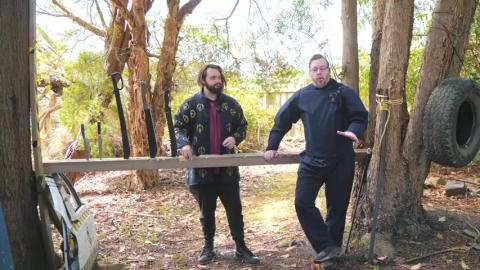IMPEACHMENT – AN IDIOT’S GUIDE
IMPEACHMENT – AN IDIOT’S
GUIDE
Hi!
This is Kodo with Kodoan. You can find out more about me at
kodoan.com.
That’s
K O D O A N DOT COM.
If
you keep hearing about Impeachment
and were kinda hoping for an “idiots guide” version of
what it is
– heads
up! this might
be just
what you’re looking for!
When
most people today here the word impeachment, they usually think of
President Donald John Trump or maybe even former President William
Jefferson Clinton – both of whom were impeached; the former, an
unprecedented two times. However, the roots of impeachment go way
back – like, 3000 years way back. Like, a thousand years older
than the Dead Sea Scrolls Papyrus way back.
I’m
referring, of course, to an Ostracon – from which we get the word
“ostracize”. Now, Ostraca, the plural form of Ostracon are
basically old timey post-it notes dating to at least the time of the
New Kingdom of Egypt – also known as the Egyptian Empire. That
would be somewhere around 1550 B.C. to 1069 B.C.
An
Ostracon was something used to scratch notes, receipts, instructions
or similar information on. It needed to be cheap, readily available
and fairly durable. Common material for Ostraca were things like a
bit of repurposed broken pottery (there was a lot of that back then),
a bit of flat limestone (there was a lot of that too) and, most
notably, flat shells such as oyster shells -from which the word
Ostracon is derived.
Right
around the same time the world was going “all Lady Gaga” over
Howard Carter’s discovery of the Tomb of Tutankhamun in 1922, the
ancient Egyptian workman’s villa known as Deir el-Medina was being
excavated. Deir el-Medina was an ancient Egyptian workman’s
village during the Egyptian Empire which was home to the artisans who
worked on the tombs in the Valley of the Kings; the location for the
Tomb of Tutankhamun.
The
ancient name for the settlement of Deir el-Medina was Set Maat –
“the place of Truth” and the workmen who lived and worked there
were called “Servants in the Place of Truth”. I’m sure that
modern day congressmen would absolutely LOVE it if people started
referring to them that way… In any case, as much as five thousand
Ostraca were uncovered at Deir el-Medina and detailed mostly mundane
everyday events such as work orders, receipts, jobsite instructions,
etc.
The
far less hardy but much more elegant Papyrus, it would seem, was
reserved for far more important writings.
“Ok”,
you say, “I got it...Ancient Egypt, Oyster shells, Ostracon are
ancient post-it notes – what the hell does that have to do with
impeachment?”
Settle
down Princess, I’m getting to the good part, then you’ll see how
it all ties together.
Towards
the end of the Egyptian Empire or just after it - in the old timey
days of King David – you know, “David and Goliath”, “King of
the Jews” and “father to Wise King Solomon” – That King
David, an Ostracon was found that is believed to be the earliest
known “vote” on a judgment. It contains the words, King, slave
and judge. There is still debate on the artifact but, if the
hypothesis holds true, it would be the oldest known use of an
Ostracon as a means of passing judgment.
During
the seige at Masada in the year 73 A.D, when the Jewish defenders
opted for mass suicide instead of capture by the invading Roman
pagans, they voted (or “drew lots”) to determine who would kill
their compatriots before falling on their own swords. Excavations at
Masada revealed Ostraca with names on them leading scholars to
believe that Ostraca were used during this “vote”.
The
importance of Ostraca was also visible during the time of Ancient
Athens, most notably the 4th, 5th, and 6th
centuries B.C., where they were used in voting for the banishment of
unpopular citizens and officials. Banishment was usually for a
period of ten years.
Ancient
Athens had its own version of a congress (called a Boule’) and a
senate (called the Areopagus – which means the “hill of Aries”
and referred to the low hill Northwest of the Acropolis).
Unfortunately,
Ancient Athens
was plagued with corruption and there
was usually a giant, corrupt, cluster screw in the middle of
everything. Things
didn’t always go according to plan nor was justice fairly meted
out. I
guess times change but people don’t. The
monkey-bonk continues...
In
any case, they believed that they were truly enlightened as the only
other viable alternative they had to banishment (“Ostracism”) was
execution; usually in the form of an assassination.
In
England, Impeachment was first used in 1376 against William 4th
Baron Latimer and the last time they used it was in 1806 against
Henry Dundas, 1st Viscount Melville. Apparently, the UK
has quite moved on from “banishing” unpopular officials in favour
of other means of coercion.
The
mechanism for impeachment in the UK is that the “house of commons”
draws up articles of impeachment (which is a fancy way of accusing
someone of something that they don’t like) and the house of lords
“hears” the case (and decides the fate of the accused). If
impeached (meaning accused of “something” – not necessarily a
crime) and then convicted, the punishment can be quite severe –
including steep fines, imprisonment or even a death sentence. Which
is exactly what befell the Earl of Stratford, Lord deputy of Ireland,
around 1639. His award for winning England’s unpopularity contest
was the end of a gallows’ rope.
In
England, impeachment was broad in scope – applicable to anyone –
not just those that held office but was primarily designed to
circumvent individuals who abused power derived from holding close
ties or favour with royalty.
Impeachment
as a part of the United States Constitution was first suggested by
Benjamin Franklin during the Constitutional Convention in 1787. He
noted that the traditional way of removing heads of state was by
removing the head of the head of the state. In other words,
execution or assassination. Franklin suggested the impeachment
process as a preferable method to the barbarism of political
violence.
Similar
to the original intent of British impeachment, the First Congress saw
impeachment as a way to remove a bad officer that was sheltered by
the power of the Presidency but their focus was primarily on a
president who might get out of control. Never-the-less, the
impeachment clause specifies any civil officer of the Executive
branch as well as judges but it excludes military officers.
The
Impeachment clause can be found in the United States Constitution,
Article 2, Section 4 where it states that the President, Vice
President and all civil Officers of the United States, shall be
removed from Office on Impeachment for, and Conviction of, Treason,
Bribery, or other high Crimes and Misdemeanors.
The
First Congress used the word “other” to connect Treason and
Bribery to other miscellaneous misdeeds. The intent was, “it
better be something serious”….not just “whatever you don’t
like about the President is reason enough for impeachment”.
However, like Ancient Athens, it is devolving into an unpopularity
contest resulting in banishment. The monkey bonk continues...
Impeachment
is not the removal of an elected official from office. It is the
first step in a two-step process that can end up in the removal of an
official from office.
The
mechanism for impeachment in the United States is quite similar to
that of the United Kingdom in that it must be initiated in the house
of representatives (our version of the “house of commons”) with
the passage of a resolution listing the charges or “articles of
impeachment” against the official being impeached.
If
passed by the house of representatives, the article or articles of
impeachment are then considered by the Senate (our version of the
“house of lords”) in a trial.
If
the impeachment is of the President or Vice-President, then the Chief
Justice of the supreme court must preside over the trial with 100
senators serving as the jury.
A
“supermajority” two thirds vote of the senate is required for a
conviction necessary to remove the person from office. Punishment is
limited to removal from office and possibly also disqualification
from holding public office in the future.
The
United States legislative branch is very far removed, indeed, from
the ancient settlement of Set Maat (the “place of truth”) and
most people would laugh if you called congress “servants in the
place of Truth”. However, there is a continuation from the first
known use of an Ostracon as a method of voting on banishment to
impeachment; our modern interpretation of banishment.
While
impeachment in the United States was supposed to be a way to reign in
unruly government officials without resorting to violence, it would
appear that it is going back to the days of Ancient Athens, and the
banishment of the unpopular – albeit with more modern versions of
Ostraca.
In
any case, I hope this “Idiot’s Guide to Impeachment” Helps you
in some way.
My
advice to you will always be three fold:
1.
Gather information
2.
Think Critically
3.
Make connections
It
has been said that the meaning of life is to learn and then to share.
In
classical martial arts, the old Masters would say, “no matter where
you start, strive to always get better”.
Remember…..no
matter where you are in life – “Always...get better!”
WAIT!!!
Before you go!
If
you liked this video, please hit the like, subscribe and “Bell”
icon buttons – it helps with those algorithms… whatever that
is….seriously...does anyone really know what the deal is with the
algorithms?
If
you do, please let me know in the comment section. Even if you don’t
know but just have something to say – let us all know in the
comment section!
Thanks
again for watching – until next time...
0



 Timcast IRL
Timcast IRL

 Matt Kohrs
Matt Kohrs
 TheSaltyCracker
TheSaltyCracker

 Life_N_Times_of_Shane_T_Hanson
Life_N_Times_of_Shane_T_Hanson
 IncelTV
IncelTV



 NerokeFive
NerokeFive





 TheQuartering
TheQuartering
 Styxhexenhammer666
Styxhexenhammer666


Log in to comment
yea, they use the term impeached as in past tense is a misnomer because they call it an impeachment trial.. Trial meaninmg where something is decided.. an impeachment trial.. Acquitted at both impeachment trials.. so was he impeached? It sure l;eaves alot of people confused..
Trump was not impeached even once.. Just came up 10 votes short in the senate...
Happy international MGTOW - day gentlemen !